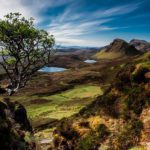A tiny and incredibly beautiful state of Sikkim, lies to the south of Tibet. It lies between Nepal to the west, Bhutan to the east and Tibet (China) to the north. This Complete Sikkim,Gangtok travel guide, will take you to the amazing Indian destination of Sikkim and its capital Gangtok. Complete information the you will need if you plan to travel to Sikkim, Gangtok.
This is the ultimate travel blog on Sikkim and Gangtok
Sikkim measures only 65km by 115km, and is the second smallest state in India after Goa.
Sikkim’s landscape varies from deep valleys just 300m above sea level so some of the highest peaks in the world. Peaks such as Kanchenjunga (Kanchendzonga to the locals) with a height of 8586m, is the third-highest mountain in the world.
A small but rapid growing network of roads spreads across this beautiful Himalayan wilderness. There has been rapid road and infrastructure development in recent years.
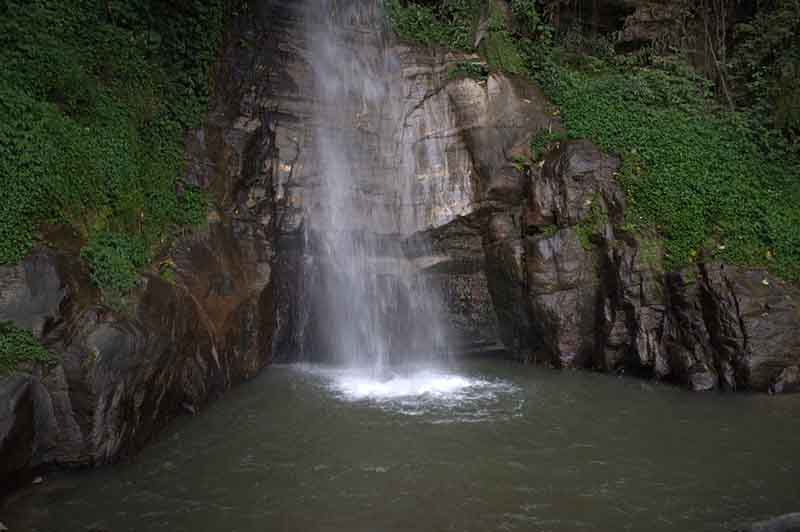
Know about Sikkim and its capital Gangtok
For centuries, Sikkim was an isolated and independent Buddhist kingdom. After a war with China in 1962, India became aware of the strategic importance of Sikkim as a crucial corridor between Tibet and Bangladesh.
As a result of its unification by India in 1975, Sikkim has experienced dramatic changes. Now a fully fledged Indian state, it is a majority Hindu State now, with a population made up of 75 percent Nepalese Gurungs, and less than twenty percent Lepchas, its former Budhdhist rulers.
Nepali is now the most spoken language, and the Nepalese are socially and politically the most dominant people in the state.
However, the people of Sikkim continue to protect their culture and affluence and remain untouched by the Nepalese Gurkhas’ autonomy movement in neighboring Darjeeling.
Although only Sikkimese can hold major shares in property and businesses, partnerships with Indian (non-Sikkimese) entrepreneurs and subsidies to indigenous Sikkimese industry have led to prosperity – fueled by its special status within the union.
Historically, culturally and spiritually, Sikkim associates more with Tibet than Indian.
Overview of Sikkim
- That tourists come to state for the off-the-beat-tracks, trekking and its monasteries, more than two hundred total, mostly belong to the ancient Nyingmapa sect.
- Pemayangtse in West Sikkim is historically most important. It has an extraordinary wooden mandala depicting Guru Rinpoche’s Heavenly Palace.
- Tashiding, a Nyingmapa monastery built in 1717, surrounded by prayer flags and chortens and looking across to snowcapped peaks, is considered Sikkim’s holiest. Rumtek is the seat of the Gyalwa Karmapa – head of the Karma Kagyu lineage – and probably the wealthiest monastery in Sikkim.
- The capital, Gangtok, a colourful, bustling cosmopolitan town, is home to a bewildering array of trekking agents only too happy to take your money in dollars and to arrange the necessary permits.
- Sikkim’s gigantic mountain walls and steep wooded hillsides, drained by torrential rivers such as the Teesta and the Rangit, are a botanist’s dream. The lower slopes abound in orchids, sprays of cardamom carpet the forest floor, and the land is rich with apple orchards, orange groves and terraced paddy fields (to the Tibetans, this was Denzong, “the land of rice”).
- At higher altitudes, monsoon mists cling to huge tracts of lichen-covered forests, where countless varieties of rhododendron carpet the hillsides and giant magnolia trees punctuate the deep verdant cover.
- Even higher, approaching the Tibetan plateau, larch and dwarf rhododendron give way to meadows abundant with gentians and potentilla.
- Sikkim’s is rich in fauna, including extremely elusive snow leopards, tahr (wild goat on the Tibet plateau), bharal (blue sheep), black bear, flying squirrels and the symbol of Sikkim – the endangered red panda.
Best Time to visit Sikkim
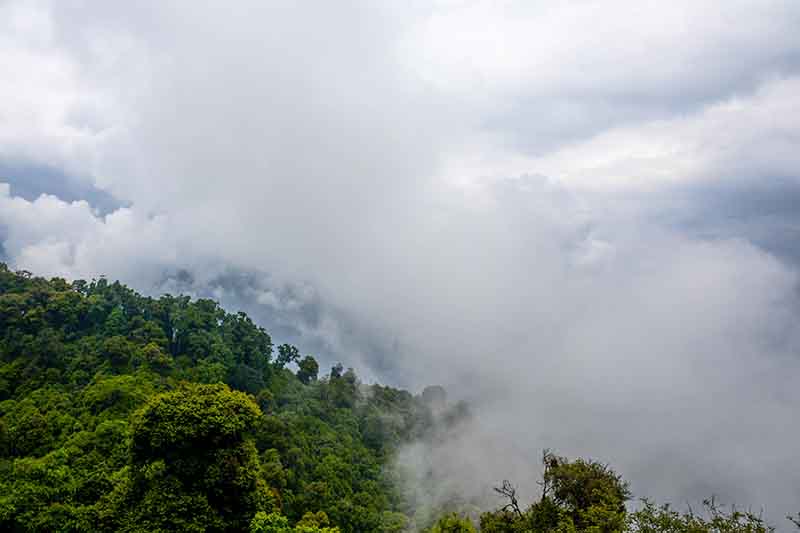
The best time to visit are in summers, from April to July, when the weather is warm with clear skies.
The monsoon is from June to September, the road conditions become worse and there are chances of landslides.
Another great time to visit Sikkim is from September to November. Temperatures are moderate, cherry blossoms are in bloom and the skies intermittently clear for views of Kanchenjunga.
However expect higher hotel rates due to tourist season, especially in Gangtok and Pelling.
During winters from February to March you can get heavy discounts when the temperature is freezing. Winter can be bitterly cold in the northern reaches, but still a good time to travel. Road closures due to snow can happen, please check the conditions when travelling in winters.
What to see in Sikkim
1. Cham Dance
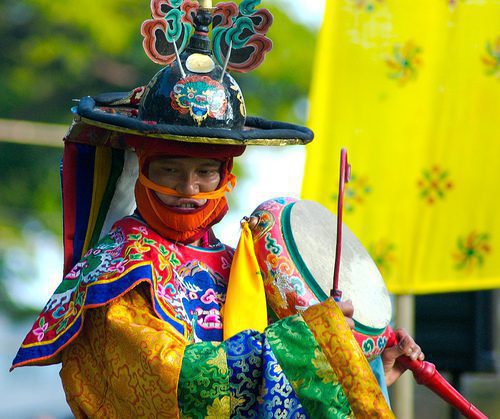
Experience this mysterious and colourful lama dance, held in most monasteries around the harvest festival of Losung (early Dec).
2 . Rumtek
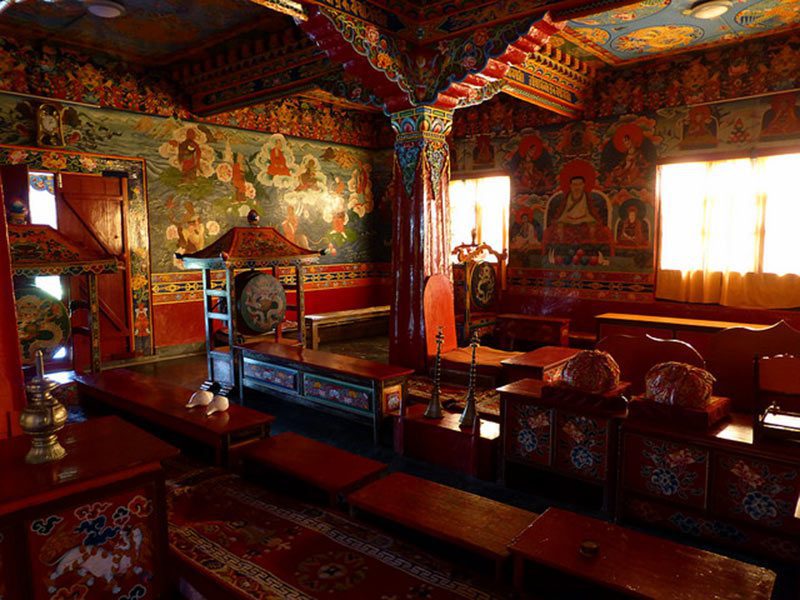
One of Sikkim’s most venerated monasteries, Rumtek is home to the Black Hat sect and hosts a spectacular festival in February.
3. Pemayangtse

A wonderful, highly venerated seventeenth-century monastery perched on a commanding ridge with glorious views.
4 . Varsey Rhododendron Sanctuary
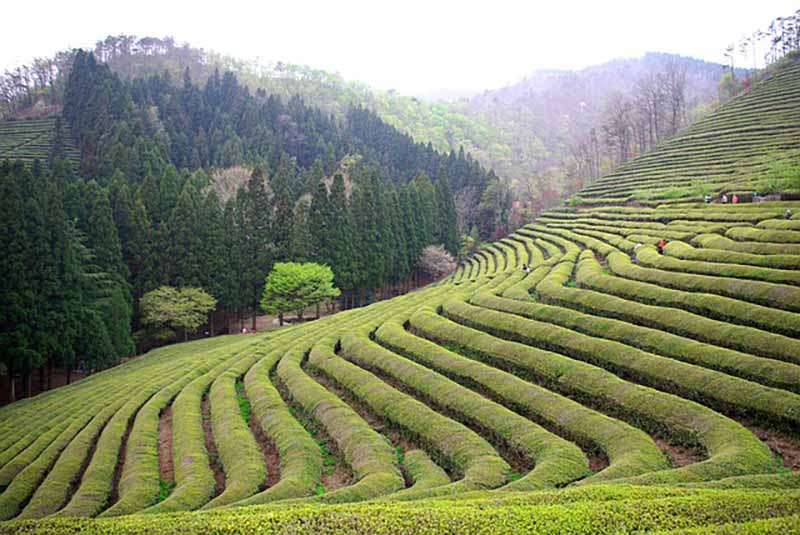
Magnificent views and gentle trails through a botanical paradise.
5. Monastery Trail
West Sikkim You won’t need porters or special permits to walk the rewarding circuit from Pelling to Khecheopalri, Yuksom and Tashiding, staying at village home-stays en route.
6. Dzongri and Singalila trails
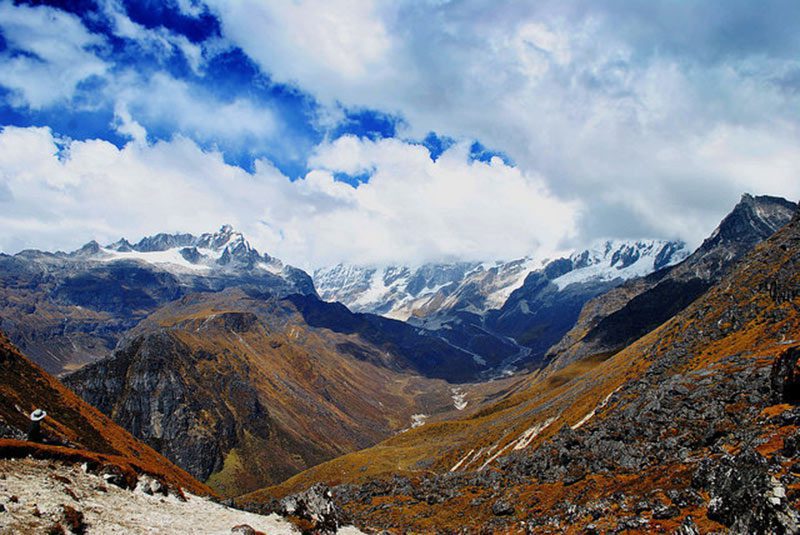
High-altitude treks through rhododendron forests, across meadows and past remote lakes with breathtaking views of mighty Kanchenjunga.
7. Tashiding
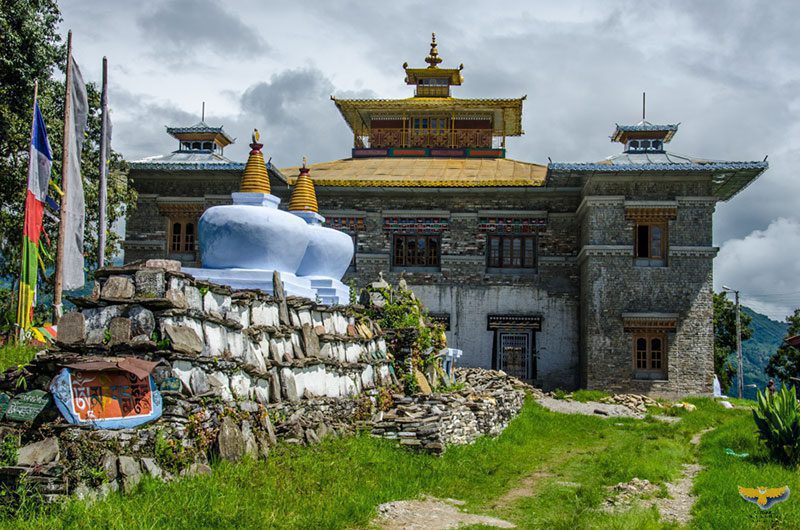
A very sacred monastic complex on a conical hill with marvellous views. Tashiding is a small village on a hilltop at West District of Sikkim in the Eastern Himalaya of India. Tashiding means “The Devoted Central Glory”. This village is about 250 m above sea level with a sub-tropical climate
8. Yumthang Valley
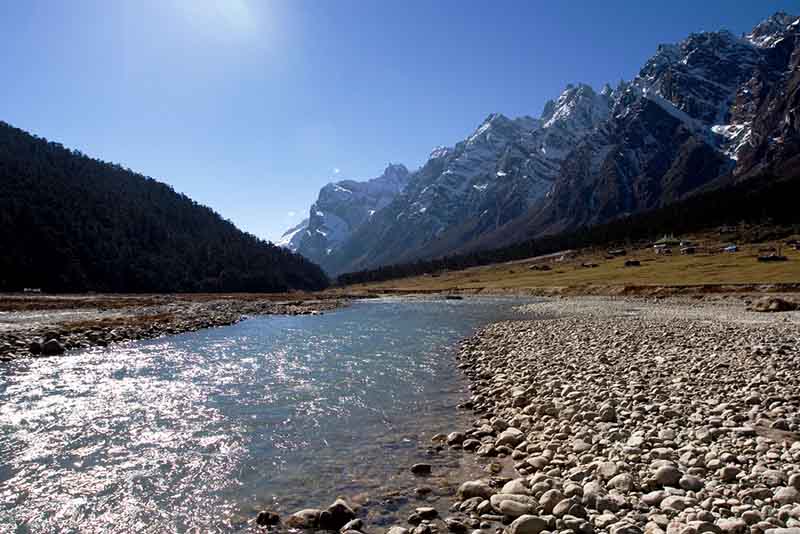
Walk through this spectacular rhododendron-filled valley with icy pinnacles towering overhead.
Amazing festivals of Sikkim
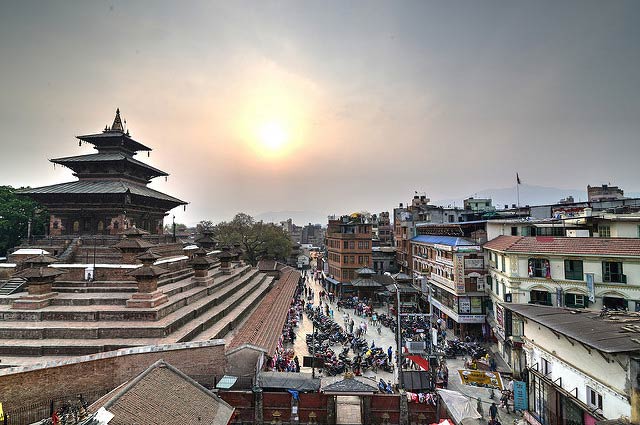
1. Losar
(in/near Feb). The Tibetan New Year, celebrated with grand monastic dances.
Bumchu Festival (Feb/March). Lamas gather at Tashiding, where a vessel containing holy water is opened and examined – the water level indicates the future of the state.
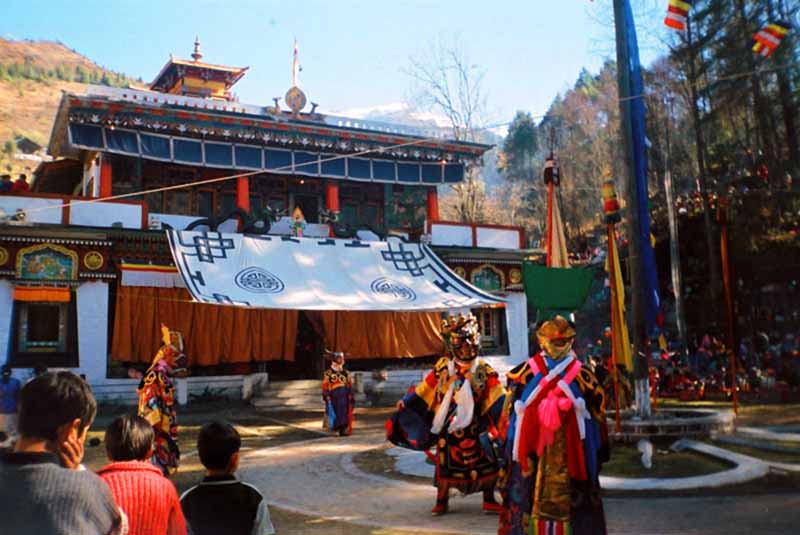
2. Dasain
(Dussehra; Sept–Oct). The Nepali community celebrates this ten-day Hindu festival marking the victory of good over evil; Goddess Durga is worshipped and her idol immersed in a river.
3. Tihar
(Diwali; Oct–Nov) The Nepali version of Diwali, this is an elaborate five-day affair, when houses are cleaned, adorned with marigolds and lit up.
4. Losoong
Loosong is the New Year festival in Sikkim and is also known as Sonam Losoong (farmer’s new year) for good harvest. Falls on the 18th day of the 10th month of the Tibetan lunar calendar, i.e. the end of December. It is a family and friends celebration.
5. Saga Dawa
Saga Dawa is the full moon day which falls on the 4th moon of Buddhist lunar calendar in the end of May or beginning of June. This festival is also popular by the name of Triple Blessed festival in Sikkim. This day is marked as the birth of Lord Buddha and is a holy festival in Buddha’s calendar.
6. Maghe Sankranti
Also known as Makar Sankranti in rest parts of India, Maghe Sankranti is celebrated on 15th of January in Sikkim (Used to be 14th January for centuries). People take a dip at the confluence of the Tista and Rangit river as a part of ritual. Melas (Fairs) are held on the river banks. Jorethang Maghe Mela in south Sikkim is one of the biggest.
Brief history of Sikkim
No one knows quite when or how the Lepchas – or the Rong, as they call themselves – came to Sikkim, but their roots can be traced back to the animist Nagas of the Indo-Burmese border.
Buddhism, which arrived from Tibet in the thirteenth century, took its distinctive Sikkimese form four centuries later, when three Tibetan monks of the old Nyingmapa order, disenchanted with the rise of the reformist Gelugpas, migrated south and gathered at Yoksum in western Sikkim.
Having consulted the oracle, they sent to Gangtok for a certain Phuntsog Namgyal, whom they crowned as the first chogyal or “righteous king” of Denzong in 1642. Both the secular and religious head of Sikkim, he was soon recognized by Tibet, and set about sweeping reforms. His domain was far larger than today’s Sikkim, taking in Kalimpong and parts of western Bhutan.
Territories lost, regained and changed hands
Over the centuries, territory was lost to the Bhutanese, the Nepalese and the British. Sikkim originally ceded Darjeeling to the East India Company as a spa in 1817, but was forced to give up all claim to it in 1861 when the kingdom was declared a protectorate of the British.
Tibet, which perceived Sikkim as a vassalage, objected and invaded in 1886, but a small British force sent in 1888 to Lhasa helped the British consolidate their hold.
By importing a Nepalese labour force to work the tea plantations of Sikkim, Darjeeling and Kalimpong, the British sought to diminish the strong Tibetan influence and helped alter the ethnic make-up of the region, with the new migrants soon outnumbering the indigenous population.
Sikkim after Indian Independence
After Indian Independence, the reforming and intensely spiritual eleventh chogyal, Tashi Namgyal, strove hard until his death in 1962 to prevent the dissolution of his kingdom. Officially Sikkim was a protectorate of India, and the role of India became increasingly crucial, with the Chinese military build-up along the northern borders that culminated in an actual invasion early in the 1960s.
His son Palden Thondup, the last chogyal, married twice; his second wife was an American, Hope Cook, whose reforms as gyalmo (queen) did not prove popular at home and irritated the Indian government.
Sikkim merger with India
The embattled Chogyal eventually succumbed to the demands of the Nepalese majority, and Sikkim was annexed by India in 1975 after a referendum with an overwhelming 97 percent majority. The Chogyal remained as a figurehead until his death in 1981.
The state continues to be treated with care by the Indian government, partly through a lingering sense of unease among the disaffected Sikkimese minority and an increasingly complex ethnic patchwork but, more importantly, because Sikkim remains a bone of contention between India and China.
Access and Permits for Trekking in Sikkim
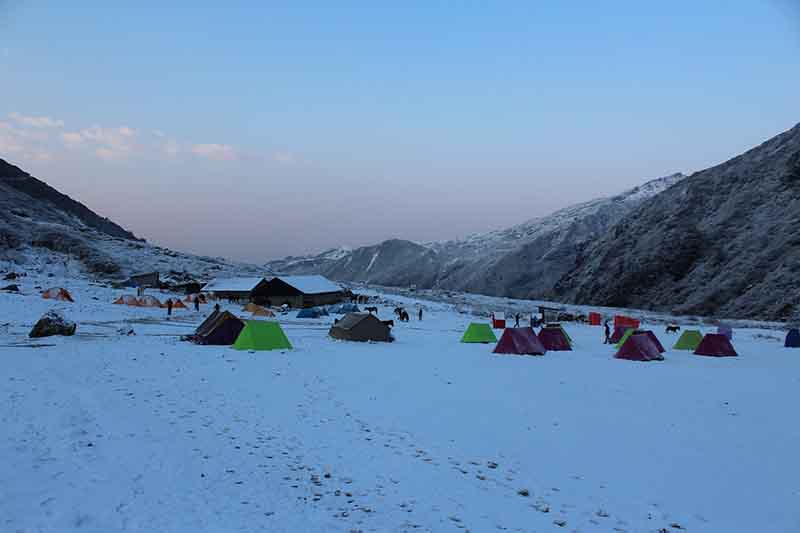
Permits to access the state- Restricted area permit in Sikkim
Foreigners have to get a Restricted Area Permit (RAP; previously known as an Inner Line Permit or ILP) to visit Sikkim. It can also be obtained online from state tracking in advance with you Indian visa,
Private vehicles are not allowed to enter the Protected Area of Sikkim without a valid permit
When in Sikkim permits are free and can be arranged through various tourism agencies and trekking operators or at the state border. Also permits are date-specific and initially valid for thirty days from entry (no return within three months); extensions are normally available up to a maximum of sixty days.
In addition to Gangtok and its surroundings in East Sikkim, the RAP covers all of South Sikkim and most areas in the east and west of the state, apart from most high-altitude treks.
Protected Area Permit for High Altitude and sensitive areas
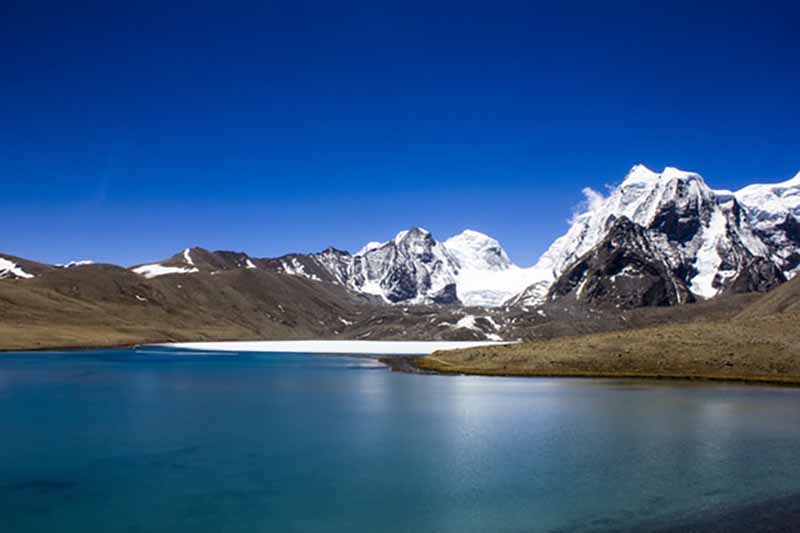
Sensitive border areas, like Tsomgo Lake (also known as Changu or Tsangu) in East Sikkim, most of North Sikkim except for Mangan and its immediate vicinity. And all high-altitude treks including the Singalila Ridge and Dzongri, require the additional Protected Area Permit (PAP); foreigners can only enter these areas in groups of at least two accompanied by representatives of approved travel agents who arrange the permits.
Permits can be instantly acquired at the Sikkim border at Melli and Rangpo. Go to the tourist office for an application form and then cross the road to have it registered by the police. If you are arriving via Darjeeling, obtain your permit there. In order to apply, you’ll need two passport photographs, and photocopies of your passport and visa.
- Airport immigration At the four main entry points: Delhi, Mumbai, Kolkata, Chennai.
- Foreigners’ Regional Registration Offices In Delhi, Mumbai, Kolkata and Chennai ( 011 2671 1384, 022 2262 1169, 033 2290 0549, or 044 2345 4970).
- New Sikkim House 14 Panchsheel Marg, Chanakyapuri, New Delhi ( 011 2611 5171).
- Sikkim tourist centre SNTC Bus Stand, Hill Cart Rd, Siliguri ( 0354 251 2646).
- Sikkim tourist information centre Sikkim House, 4/1 Middleton St, Kolkata ( 033 2281 7905).
Trekking and Mountaineering Permits in Sikkim
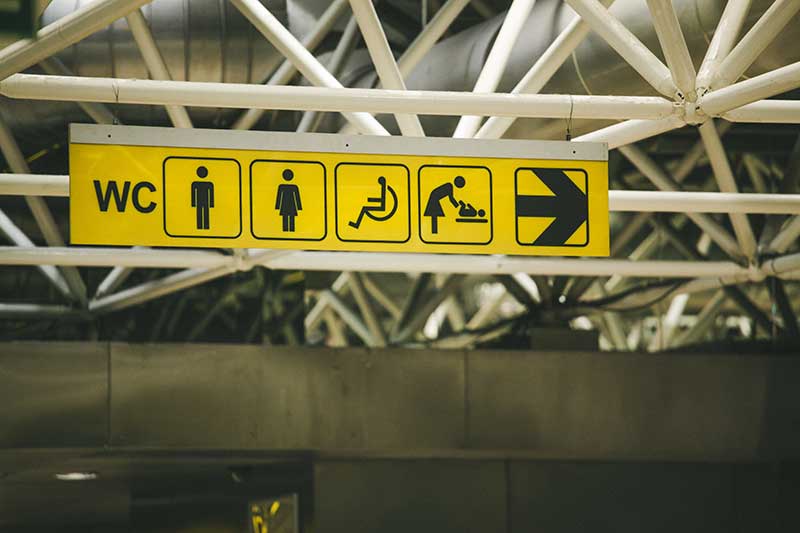
Foreigners have to acquire trekking permits (aka Protected Area Permits or PAP), which also act as entry permits for these areas. These are only available from the Sikkim Tourism offices in Gangtok, but can be arranged through trek operators.
- Carefully check documents and itineraries – you don’t want to be rushed, especially at altitude – before you set off. Trekking parties consist of a minimum of two people; tour operators charge an official daily rate of US$60 to US$150 per head per day, depending on group size and route.
- While most major peaks require permission from the Indian Mountaineering Foundation (IMF) in Delhi. It needs three months’ notice. as well as mountaineering permits. The Sikkim government, through the appropriate Gangtok trekking operator, hands out permits for the following treks: Frey’s Peak (5830m) near Chaurikhang on the Singalila Ridge; Thingchenkang (6010m) near Dzongri and Jopuno (5935m) in West Sikkim; and Lama Wangden (5868m) and Brumkhangse (5635m) in North Sikkim. Recommended Gangtok agents include Namgyal Treks and Tours.
- The high-altitude treks most commonly offered by the operators are the Dzongri–Goecha La route. Its variation starting from Uttarey and the Singalila Ridge. The exhilarating trek from Lachen to Green Lake is possible, but permission must be obtained from Delhi (most easily arranged through a Gangtok agent) at least two months in advance.
- At the moment, Dzongri still bears the brunt of the trekking industry in the state, and the pressure is beginning to tell severely on the environment.
- Low-altitude hikes often come without the restriction of permits. It makes Sikkim an attractive destination for quiet walks off the beaten track. The rhododendron trails around Varshey, West Sikkim, for example, are particularly pleasant.
A word of warning
- Do not trek without company in forest areas due to the risk of black bears and other wild animals
- Few areas such as Nathu La Pass on the border with Tibet in East Sikkim, and Gurudongma Lake in North Sikkim are completely off-limits to foreigners due to border sensitivities with China.
Gangtok
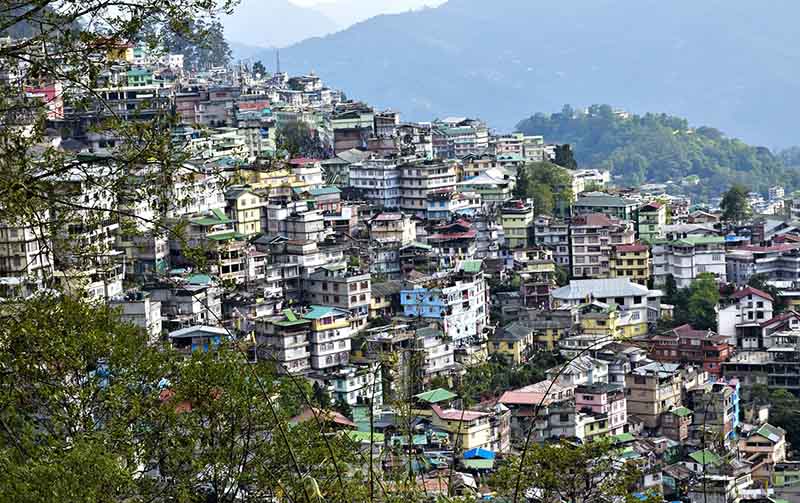
The Capital of Sikkim, the colorful hill-town of Gangtok(1650m) occupies a rising ridge in the southeast of the state. It used to be a busy trade route into Tibet. Today, rapid development means an ugly assortment of concrete multistory buildings is growing virtually unchecked. The urban new buildings retains only a few traditional Sikkimese architectural elements.
A short walk however, leads you away from the congested center to occasional glimpses of the snow-capped Himalayas, and on a clear day you can see Kanchenjunga, the horned peak of Narsing (5825m) and the fluted pyramid of Siniolchu (6887m) poking above the surrounding hills.
While modern Gangtok epitomizes the recent changes in Sikkimese culture and politics, its Buddhist past is the root of its appeal for visitors, evident in the collection at the Institute of Tibetology and the charming Enchey Monastery, as well as the impressive Rumtek Monastery, 24km west of town.
However, the palace on the tree-lined promenade, the Ridge above town, used by the chogyals between 1894 and 1975, is now out of bounds, part-occupied by the government and a closed chapter in Sikkim’s heritage. Sikkim’s pride and joy, orchids, are nurtured at several sites in and around Gangtok, and celebrated at the Flower Show Complex, also on the Ridge.
Most of the town itself looks west and one explanation for the lack of development east of the ridge is that tradition dictates that houses face northwest, towards Kanchenjunga, Sikkim’s guardian.
Places to Visit in Gangtok
Enchey Monastery

3km northeast from the center
• Mon–Sat daylight hours
• Free
• A picturesque hour-long walk heading north from the Ridge and Flower
Show Complex
Right at the top of town and just below a colossal telecom tower, sits Enchey Monastery, a small two-storey Nyingmapa gompa. Visitors are welcome and the best time to go is between 7am and 8am, when the monastery is busy and the light is good.
The monastery was built in the mid-nineteenth century on a site blessed by the Tantric master Druptob Karpo, who wasfabled for his ability to fly. Surrounded by tall pines, and housing more than a hundred monks, the building suffered some damage in the 2011 earthquake, but remains a gem of a place.
Built by the chogyal on traditional Tibetan lines, the prayer hall’s beautifully painted porch has murals of protective deities and the wheel of law, also while the conch shells that grace the doors are auspicious Buddhist symbols. Enchey holds an annual Chaam, or masked lama dance, during the Losung festival, usually held in early December.
Earthquake, Landslides and Dams
Although earthquakes are a common occurrence throughout the Himalayas, the one that struck in September 2011, with its epicentre at Mangan, 42km northwest of Gangtok, was particularly destructive, leaving around sixty people dead and a trail of devastation as far away as Gangtok.
Dams
Industrialization and the construction of dams and numerous hydroelectric projects on Sikkim’s rivers, such as the Teesta, putss pressure on the state’s diminishing indigenous population and threatening their lifestyle and heritage, particularly in Dzongu, the heartland of Lepchas.
Although the voice of their protest is now all but lost, the destruction of habitat and the extraordinary strain on the state’s fragile road system is self-evident.
Ganesh Tok and around.
A steep 1km climb past the TV tower from Enchey
View-points
A spectacular viewpoint festooned with prayer flags, Ganesh Tok provides a sweeping view of the city sprawling below. A further 5km up the road to Tsomgo Lake, Hanuman Tok (2300m) is another viewpoint with vistas of eastern Sikkim, and is the cremation ground of the Royal Family, with chortens containing relics of the deceased; the Hanuman temple after which the spot is named is more recent.
Himalayan Zoological Park
Opposite Ganesh Tok • Daily except Thurs 9am–4pm • ₹50 (₹25), car ₹40
Visitors come to the 506-acre Himalayan Zoological Park in the hope of catching a glimpse of the red pandas (which are especially easy to spot), snow leopards, bears and Tibetan wolves that roam the extensive open-air enclosures.
The Ridge
Midway between MG Marg and Enchey
The quiet leafy promenade of the Ridge is a popular spot, with the Flower Show Complex and a small park at the northern end, and at the southern end, the Royal Palace. The Secretariat, south of the compound, was devastated by the 2011 and is rebuilt.
Tsuklakhang
At the far end of the Royal Palace compound, best accessed through the rear gates of the compound
Visitors usually gets access to Tsuklakhang, the chapel in the Royal Palace which is otherwise out of bounds. The monastic complex has several resident monks and the chapel has impressive murals, Buddhist images and a vast collection of manuscripts.
A lama dance, known as kagyat, usually takes place here at the end of December, during which the main gates are open to the public (though some years it’s in Pemayangtse). Across the lawns lies the Royal Palace, used by the chogyals (Sikkim’s former rulers) until 1975. Following the state’s annexation by India, the palace lies mostly abandoned, a prisoner of circumstance.
Institute of Tibetology
2km south of the centre of Gangtok, in Deorali • Mon–Sat 10am–4pm, closed 2nd Sat of each month • ₹10
South of Gangtok at Deorali, the lower part of town, set in wooded grounds, is the museum-cum-library of the Institute of Tibetology with its impressive and invaluable collection of books and rare manuscripts, as well as religious artefacts such as exquisite thangkas (scrolls) and a photography archive. You can also get here from the upper town via the ropeway cable car.
Do-Drul Chorten
About 50m east of the Institute of Tibetology
Within the same complex as the Institute of Tibetology, an imposing whitewashed chorten, known as the Do-Drul Chorten – one of the most important in Sikkim – dominates a large, lively monastic seminary on the brow of a hill. The chorten is capped by a gilded tower, whose rising steps signify the thirteen steps to nirvana; the sun and moon symbol at the top stands for the union of opposites and the elements of ether and air, surrounded by 108 prayer wheels.
Behind the monastic complex, a prayer hall houses a large image of Guru Rinpoche (Padmasambhava) who brought Buddhism to Tibet at the request of King Trisong Detsen in the eighth century AD. He later travelled through Sikkim hiding precious manuscripts (termas) in caves, for discovery at a future date by tertons. Curiously, part of the head of the image projects into the ceiling; belief has it that the image is slowly growing.
How to reach: Sikkim, Gangtok
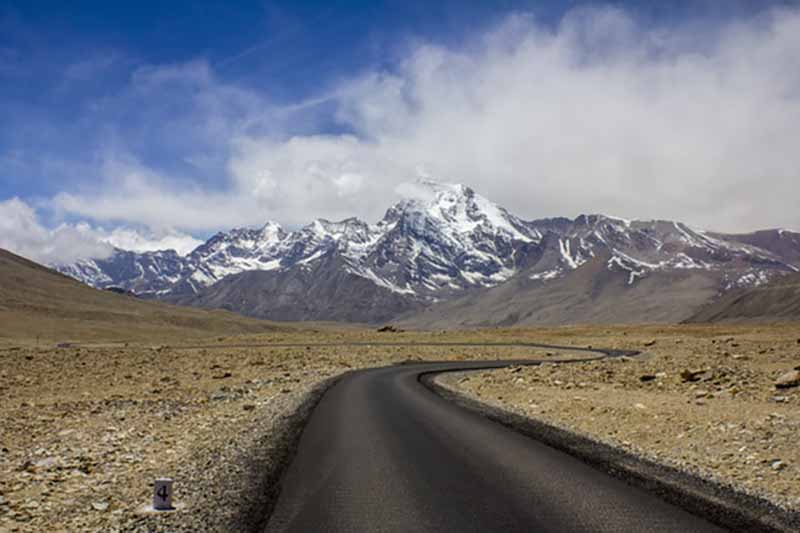
By Road
With the deterioration in Sikkim’s roads, shared jeeps and taxis are far more popular and efficient than buses for accessing Gangtok. Due to the Gurkha agitation in neighboring Darjeeling district, the busy route to and from Siliguri in West Bengal sees occasional closures, though the authorities endeavor to keep it open.
By jeep Most travellers arrive by jeep from Siliguri (4hr 30min), the current transport centre for the railhead at New Jalpaiguri (NJP; 117km) and for Bagdogra airport (124km). Jeeps to North Sikkim depart from the Vajra stand until 1pm.
Destinations from Mainline taxi stand: Darjeeling (5–6hr; ₹200); Kalimpong (3–4hr; ₹150), New Jalpaiguri (NJP; ₹250); Siliguri (5–6hr; ₹200).
Destinations from taxi stand near MG Marg: Gyalshing (4–5hr; ₹200); Jorethang (3–4hr; ₹150); Pelling (5–6hr; ₹300); Rumtek (1hr; ₹50).
Destination from Vajra taxi stand: Mangan (3hr; ₹130).
-
By Bus
If you’re determined to suffer the buses, you can choose between the state carrier, SNT (Sikkim Nationalized Transport), or a number of private operators. All buses run by SNT use the SNT Bus Stand on Paljor Stadium Rd, but passengers may prefer to drop off earlier at Metro Point, MG Marg, which is more convenient for the tourist office and most hotels. Non-SNT buses stop at the Mainline Stand, Deorali, 2km south of the centre.
Destinations Bagdogra airport, via Siliguri (hourly till 3pm; 5–6hr); Jorethang (daily at noon; 4hr); Siliguri (hourly till 3pm; 5–6hr).
-
By Train
The nearest railway station, New Jalpaiguri (NJP), is 117km away. SNT has a train reservations counter (Mon–Sat 8am–2pm), but the reservations quota for Gangtok is highly inadequate so you it is advisable to book in Siliguri or online.
-
By Air
An airport at Pakyong (35km) southeast of Gangtok will start operations from October 2018. Until then, Bagdogra (5hr) is the nearest airport.
By helicopter Sikkim Tourism Development Corporation (STDC) sells tickets for the helicopter flight (subject to weather conditions; daily 10am and 11.35am; ₹3500; 35min) to Bagdogra. Note that the flights only operate with a full load of five passengers and baggage allowance is a mere 10kg.
Getting around
By taxi Shared local taxis are the most common way of travelling the main highway (Gangtok to Deorali around ₹10). After 8pm, taxis become scarce but reserved taxis are available from stands near the SNT Bus Stand; the Private Bus Stand at Deorali; the Lal Bazar supermarket; Children’s Park between MG Marg and Tibet Rd; and the Main Line jeep stand. All taxis carry a rate chart, and drivers are generally honest.
By the ropeway With terminals at the old Secretariat, Nam Nang and Deorali, the ropeway (daily 8am–4.30pm) provides a spectacular view of the southern city, though it’s an expensive way to get around by local standards (₹80 return, no one-way fare) and is not particularly useful for most accommodation. While it’s should run every 12min by rule, in practice it waits to fill up before moving on.
How about some food and drinks, in Sikkim
Food
Sikkimese food inluenced by Nepalese, Tibetan and Indian. Rice is a staple, eaten with dal, forest vegetables and pickles, including the supremely hot, fire-engine-red dalley chilli pickle. Churpi, a fresh cow-milk cheese, is generally made with a fern called ningro. Gyakho is a traditional chimney stew for special occasions.
Phing (glass noodles), shisnu (nettle soup), gundruk (fermented spinach), gyathuk (soup with handmade macaroni and local herbs; usually with beef) are other typical specialities, along with chicken, pork and beef dishes. Khodo (millet pancake) and fafar roti (buckwheat pancake) is a common breakfast. Tibetan dishes including momos and thukpa are available easily.
Drinks
Restaurants in Gangtok serve alcohol; Hit and Dansberg are the local Sikkimese beer brands. Look out for tomba, a traditional drink usually served in winter, consisting of fermented millet served in a wooden or bamboo mug and sipped through a bamboo straw.
The mug is periodically topped up with hot water and after a wait of few minutes, you’re left with a pleasant warm, watery drink that’s best on a cold evening. Chaang is a local millet beer, milky and fermented, is more commonly in home-stays.
Eating
Though Gangtok has become a modern town with hip eateries and bars, most places still wrap up by 9PM.
Cane furniture lends a rustic vibe, and traditional set meals include rice, vegetables, a meat curry and local drinks such as so-chang (millet beer) or the Nepali liquor raksi. There’s a selection of Bhutanese dishes along with the usual Indian and Chinese; expect to pay ₹900 for two. Live music on some evenings. Daily 11am–9.30pm.
Shopping in Sikkim
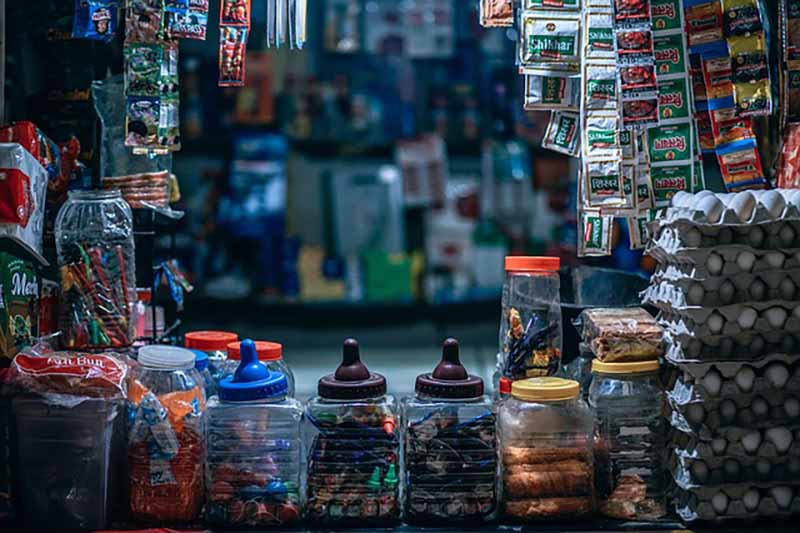
The town’s best shopping areas are the Main Market, stretching for 1km along the pedestrianized MG Marg, and the local produce bazaar in the concrete Kanchenjunga Shopping Complex (Lal Bazar).
Here, stalls sell dried fish, dri (female yak) cheese (churpi), and yeast for making the local beer, tomba, Also on Sundays, there’s a haat (bazaar) when people from surrounding areas sell traditional wares from the villages. Curio shops on MG Marg and on Paljor Stadium Rd sell turquoise and coral jewellery, plus religious objects such as silver ritual bowls and beads.
Handloom and Handicraft Emporium NH-31A, north of the centre 03592 203126. Workshops and a retail outlet for traditional Sikkimese handicraft including carpets, handloomed fabrics, thangka paintings and wooden objects; fix price shops and you can visit the workshops. Mon–Sat 10am–4pm.
Sikkim,Gangtok Travel Guide, Please do share the post if you liked it. Happy Journey to the the raw natural beauty in India. Stay safe and enjoy full!




